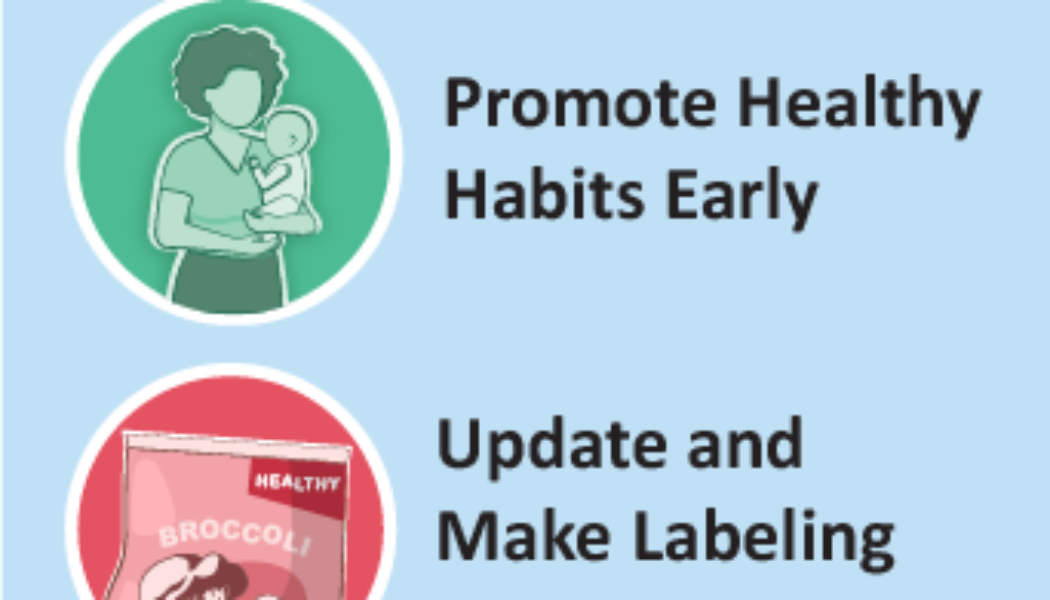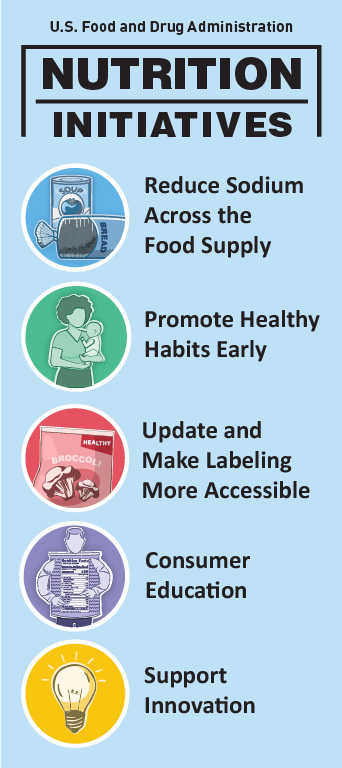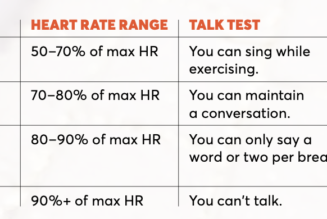The FDA is prioritizing its nutrition initiatives to ensure people in the United States have greater access to healthier foods and nutrition information we can all use to identify healthier choices more easily. Increasing the availability of healthier foods could improve eating patterns and, as a result, improve everyone’s health and wellness.
At its Conference on Hunger, Nutrition and Health on September 28, 2022, the White House released a National Strategy to end hunger and increase healthy eating and physical activity by 2030, so that fewer consumers experience diet-related diseases like diabetes, obesity and hypertension. The strategy includes several FDA initiatives to help accelerate efforts to empower consumers with information and create a healthier food supply, such as: developing an updated definition and a voluntary symbol for the “healthy” nutrient content claim, front-of-package labeling, and Dietary Guidance Statements on food labels, as well as gathering input for nutrition labeling for groceries sold online. The strategy also reflects the need to encourage the production of healthier foods by including targets to reduce sodium in foods and providing greater flexibility to industry around the use of salt in standardized foods. The FDA also will explore additional ways to reduce added sugars in foods to complement its requirement that added sugars be included on the Nutrition Facts label. On November 6-8, 2023, the FDA will hold a virtual meeting and listening sessions on strategies to reduce added sugar consumption in the United States.
Eating patterns in the U.S. do not align with federal dietary recommendations. Most people in the U.S. do not eat enough fruits, vegetables, dairy, whole grains and healthy oils, and consume too much saturated fat, sodium and added sugars. Healthy eating is influenced by a variety of factors including access to healthy, safe, and affordable foods as well as consumers’ knowledge, preferences, and culture. At the FDA, we want to have an impact on eating patterns by encouraging industry to make healthier foods and by providing information so that consumers can make healthier choices.
The U.S. faces an ever-growing epidemic of diet-related chronic diseases such as cardiovascular disease, diabetes and obesity. Poor nutrition plays a key role in chronic but preventable diseases, which are leading causes of death and disability in the U.S. Racial and ethnic minority groups, those with lower socioeconomic status and those living in rural areas disproportionately experience these diet-related chronic diseases. Additionally, the pandemic made it very clear that we need to improve nutrition, given that people with obesity, diabetes, and other chronic diseases have an increased risk of severe symptoms and death from COVID-19. In 2021, CDC issued a report indicating that sharp increases in Body Mass Index rates occurred during the COVID-19 pandemic; those with overweight or obesity and younger school-aged children experienced the largest increases.
FDA’s Role
The FDA plays a key role within a broader, whole-of-government approach to help reduce the burden of chronic diseases and advance health equity by helping to improve dietary patterns in the U.S.
For example, food labeling can be a powerful tool for change. It empowers consumers with information they can use to identify healthier foods. In addition to helping consumers with their food choices, food labeling may help foster a healthier food supply if some manufacturers reformulate to create healthier products.
The FDA has taken some significant steps to support consumers in making healthier choices. For example, the FDA updated the Nutrition Facts label with a refreshed design and updated information, including the declaration of added sugars (consuming too much added sugars can make it difficult to meet nutrient needs while staying within calorie limits). Calories are also now required to be declared on certain menus and menu boards to better equip consumers with nutrition information when they eat away from home. Most recently, the FDA issued voluntary sodium reduction targets for industry in a wide variety of processed, packaged and prepared foods as part of an ongoing effort to reduce sodium in the food supply.
The FDA knows more needs to be done. We will continue to focus on creating a healthier food supply, empowering consumers and helping establish healthy starts for our youngest populations. Working with our federal partners in a whole-of-government approach, we can dramatically reduce the risk of diet-related chronic diseases, advance health equity, and improve the health of future generations.
Key Elements
On average, people in the U.S. consume 50% more sodium than the recommended limit for those 14 years and older. Excess sodium can result in hypertension – or high blood pressure – which in turn increases the risk for heart attacks and strokes. More than 4 in 10 American adults have high blood pressure, and that number increases to about 6 in 10 for non-Hispanic Black adults. About 70% of sodium intake comes from packaged and restaurant foods, making it challenging for consumers to reduce sodium intake. As a first step in an iterative approach to reduce sodium across the food supply, in October 2021, the FDA issued voluntary sodium reduction targets for the food industry in a wide variety of processed, packaged and prepared foods. The FDA plans to monitor the food supply and develop updated, revised targets in the future.
The Dietary Guidelines for Americans, 2020-2025, for the first time includes nutrition guidance for children under 2 years of age and expands guidance for those who are pregnant or breastfeeding. These updates allow the FDA to expand our work that affects these critical populations. Healthy dietary patterns early in life can influence the trajectory of eating habits and health behaviors throughout life. Our work focuses on three key areas:
- FDA/EPA fish advice. In October 2021, the FDA, in coordination with the Environmental Protection Agency, published updated advice to help those who might become pregnant, are pregnant or breastfeeding, and parents and caregivers who are feeding children make informed choices about fish that are nutritious and safe to eat. Seafood provides beneficial fatty acids and other nutrients that can help children’s growth and development. The FDA continues to work on developing a variety of educational materials—including the release of new infographics for consumers in October 2021—to enhance the ability of consumers to follow the advice and to encourage the consumption of seafood lower in mercury among these populations. In addition, the FDA and federal partners have launched a study on the role of seafood consumption in child growth and development.
- Infant formula premarket review. Infant formula is a significant or even sole source of nutrition for many infants during a critical period of growth and development. The majority of infants in the U.S. receive infant formula by 6 months of age. The FDA requires certain nutrients in infant formulas, and infant formula manufacturers are required to make a submission containing detailed information on the safety and nutritional adequacy of a new infant formula to the FDA before introducing new infant formulas in interstate commerce. These submissions are increasing in both quantity and complexity. The FDA is working to expand consumer access to infant formula products, while also ensuring that these products meet the agency’s safety, nutrition and quality standards. The FDA is also looking at the latest science on novel infant formula ingredients, including new “bioactive” ingredients that are similar to components of human milk.
- Promoting nutritious and safe food choices. The FDA will continue to work with its federal partners to develop additional education and outreach efforts to ensure that those who are pregnant or might become pregnant, as well as parents and caregivers, are aware of current recommendations for healthy eating patterns. As the FDA implements Closer to Zero initiative, we will ensure that parents and caregivers have accessible, science-based information to help make nutritious choices to ensure their children’s healthy development, while reducing exposure to toxic elements from foods to as low as feasible.
Claims and symbols can act as quick signals on the front of food packages to help consumers better understand nutrition information and select foods that are part of healthy eating patterns. Other aspects of food labels can provide consumers with further valuable information to help them to identify healthier foods. The desire to use certain labeling on their food packages can also encourage food manufacturers to reformulate and develop healthier foods. For example, after trans fat was required to be declared on the Nutrition Facts label in 2006, trans fat was reduced by almost 80% in the food supply. The FDA’s work in labeling and claims includes:
- Providing food companies with guidance on the use of Dietary Guidance Statements. In keeping with the Dietary Guidelines for Americans’ focus on eating patterns and food groups, on March 23, 2023, the FDA issued draft guidance for industry on statements that could be used on food packages to help consumers understand how a food or food group can contribute to a nutritious eating pattern.
- Updating the nutrient content claim “healthy.” The FDA issued a proposed rule on September 28, 2022 to update the definition of the “healthy” claim that can appear on food packages to align it with current nutrition and dietary guidance, as well as the Nutrition Facts label. Updating the voluntary “healthy” claim will help consumers more easily identify foods that are consistent with healthy eating patterns and some manufacturers may reformulate and produce new foods in order to bear the “healthy” claim.
- Developing a “healthy” symbol. To further help consumers easily identify packaged foods that would meet an updated “healthy” definition, the FDA is conducting consumer research to develop a “healthy” symbol that could appear on food packages.
- Front-of-pack labeling. The FDA is planning to develop a front-of-package—or FOP—labeling system that consumers can use to quickly and easily identify foods that are part of a healthy eating pattern. Use of these schemes has increased dramatically around the world in recent years. FOP systems can promote equitable access to nutrition information, particularly to those with less nutrition knowledge.
- Exploring recommendations for nutrition, ingredient, and allergen labeling information for online grocery shopping. Consumers are increasingly using e-commerce to shop for groceries. This trend accelerated during the COVID-19 pandemic. The increase in online grocery shopping is an opportunity to ensure consumers are able to access label information that will help them make more informed and healthier food choices. Therefore, it is important for the FDA to learn more about what and how food labeling information is available to consumers at the point of purchase when grocery shopping online. As a first step, the FDA discussed labeling in online grocery shopping in a session at the FDA’s New Era E-Commerce Summit in October 2021. On April 24, 2023, the FDA published a request for information to obtain current information on the content, format, and accuracy of food label information that is presented to consumers through online grocery shopping platforms.
Providing tailored education on labeling and nutrition is a key principle throughout each of the key elements in FDA’s Nutrition Initiatives. Education is an important element in helping improve consumers’ diets. Providing materials to consumers about how to use food labeling empowers them with information to build healthier eating patterns. For example, in 2020 the FDA launched a national consumer education campaign to increase awareness and use of the updated Nutrition Facts label. The FDA will continue its education efforts on its labeling and nutrition work by developing and promoting education materials that are designed for various audiences, including racial and ethnic minority groups, as well as parents and caregivers.
Creating healthier foods depends, in part, on industry’s ability to innovate. Standards of identity (SOI) establish guardrails on the composition of certain foods that may include specifying mandatory or optional ingredients and production methods. There are SOIs for foods such as milk and certain cheeses, juices, and breads and many more. Updating SOI can enable industry to innovate, and in some cases, produce healthier food. Our SOI work that focuses on nutrition includes:
- Establishing SOI principles to help determine when to establish, revise or eliminate a food standard. A key factor in these principles will be maintaining the nutritional quality of a standardized food as well as supporting innovation and determining how food standards fit into an evolving food supply. A joint FDA and USDA effort to publish a new proposed rule on principles for food standards modernization was included in the most recent Unified Agenda.
- Published draft guidance on the labeling of plant-based milk alternatives. The FDA recognizes there’s been rapid growth of plant-based foods, including plant-based milk alternatives. The FDA wants to ensure that industry can continue developing such products, while ensuring consumers understand the nature of the products and their nutritional content. This guidance is the agency’s next step after issuing a notice in 2018 requesting comment on the labeling of plant-based alternatives with names that include the names of dairy foods.
Progress
| Initiative | Progress |
|---|---|
| Sodium Reduction |
|
| Maternal and Infant Health and Nutrition |
|
| Labeling and Claims |
|
| Consumer Education | |
|
Support Innovation |
|









